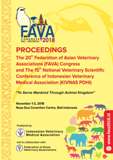AQ-7 Analyses of Environment Factors Influencing Surra Outbreak in Sumba Timur Nusa Tenggara Timur - Indonesia
Abstract
Surra is a disease caused by Trypanosoma evansi haemoparasit [1]. The parasite was first discovered by Griffith Evans, a British veterinarian, who described T. evansi on horse and camel blood in India in 1880. The disease is characterized by anemia, weight loss, intermittent fever, and death in various domestic animals, such as horses, cows, buffalo, and camels. Recently T. evansi has been successfully isolated from animals (carnivores) at zoos in Pakistan [2]. The disease can be transmitted vertically and horizontally. Transmission horizontally through the bite of a fly (Tabanidae and Stomoxis) acting as a mechanical vector [3].Surra is present in North Africa, The midle east, Asia and South America. The disease is endemic in India, China, Shouteast Asia, Northen Africa, The Middle East, South America, Philippines, Bulgaria and Indonesia [4]. T. evansi have entered Southeast Asia through imported livestock from India [5], and began attacking the horse population on the Indonesian island of Java in 1987 [5]. Since it was first discovered, the disease continues spread to various regions and become endemic in some provinces in Indonesia.
Sumba Island East Nusa Tenggara Province is one of the islands declared a free area of Surra until 2009, when Surra entered the island due to livestock traffic. Historically Sumba Island has a horse Sandelwood (germplasm) with high economic and social cultural value, and one of Indonesia's livestock producers with high livestock population.
Surra infected livestock of Sumba islands due to traffic of livestock from endemic area such as Bima, The outbreak in Sumba Barat Daya occurred in July 2010 and spread Sumba Timur on August 2010. The outbreak resulted in the death of 44 horses (2010), 381 horses and 20 water buffaloes (2011) and 328 horses and 129 water buffaloes 2012 (The Livestock Service of East Sumba Report).
Horses, water buffaloes and cows for Sumba society not only as a fulfillment of protein needs but also as social symbols and customary animals are very important for the life of the people of sumba. Surra poses a threat to people's lives both economically and socially. Surra influenced by several factors such as geographical condition, vector existence, rearing system and physiological condition of animal [6]. The aim of this study are to analyze correlation of environment factors with Surra outbreak.

